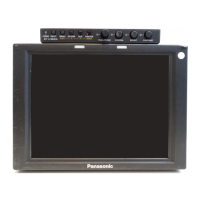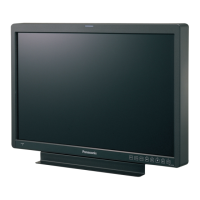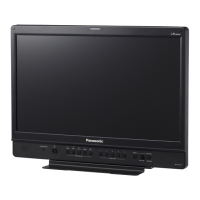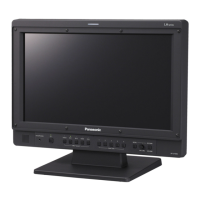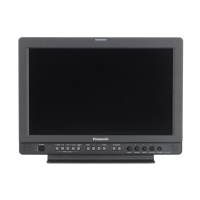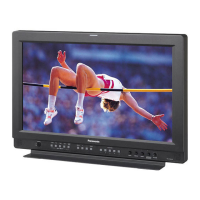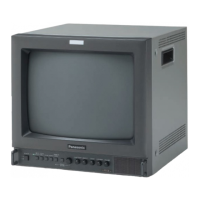57
HORIZONTAL/VERTICAL IMAGE POSITION, IMAGE AMPLITUDE AND IMAGE DISTORTION ADJUSTMENTS (SDTV UNDERSCAN 4:3 MODE)
Notes: • Perform the following adjustments after completing the
Reference Mode (SDTV overscan 4:3 mode) adjustments.
• The data adjusted for the reference mode becomes the
reference value for the SDTV underscan 4:3 mode and
SDTV overscan/underscan 16:9 modes. When the data of
the reference mode is changed, it is required to re-adjust
the underscan data and SDTV overscan/underscan 16:9
mode data for the same adjustment signal.
1. Apply the 480/60i size adjustment signal to INPUT A (Terminal Y on
the Component/RGB Input Card).
2. Set the CONTRAST and BRIGHT potentiometers on the front panel
to the center click positions.
3. Press the UNDER SCAN button on the front panel to set the scan-
ning size to underscanning.
4. Adjust DF04 in the Service Menu to set the vertical position of the
image at the center of the CRT screen.
5. Adjust DF02 to set the vertical amplitude of the image to 233mm.
6. Apply the 480/60i crosshatch signal to INPUT A.
7. Adjust DF11 to set the sizes of the rectangles at the center of the
image and those at the left and right ends to be identical.
8. Adjust DF12 to set the sizes of the rectangles at the center of the
image and those at the top and bottom to be identical.
9. Ensure that the center position is not deviated. If it is, adjust DF04
again.
10. Adjust DF11, DF12 and DF04 repeatedly until the center position
and vertical linearity are optimized.
11. Adjust DF09 to optimize the trapezoidal distortion (observe the sec-
ond vertical lines from the left and right edges as the reference).
12. Adjust DF08 to optimize the parallelogram distortion (observe the
second vertical lines from the left and right edges as the reference).
13. Adjust DF10 to optimize the horizontal arc distortion.
14. Adjust DF05 so that the second vertical lines from the left and right
edges are linear.
15. If there is an extreme corner S-shape distortion, adjust DF07 to
optimize it (this adjustment is usually unnecessary).
16. If there is an extreme corner W-shape distortion, adjust DF06 to
optimize it (this adjustment is usually unnecessary).
17. Apply the 480/60i size adjustment signal to INPUT A.
18. Ensure that the vertical amplitude of the image is 233mm. If it is
not, adjust DF02 again.
19. Adjust DF03 so that the horizontal position of the image comes at
the center of the CRT screen.
20. Adjust DF01 to set the size adjustment signals at 7mm from the
escutcheons on the left and right side of the image.
21. Vary the adjustment signal and adjustment data, and re-perform
adjustments in steps 1 to 20 above (see Table 11).
Measuring Instruments Signal generator (Size adjustment signal, Crosshatch signal)
Card (Slot) Component/RGB Input Card (Slot 1)
Test Points
Adjustment Points D*01 (Horizontal Size), D*02 (Vertical Size), D*03 (Horizontal Position), D*04 (Vertical Position), D*05 (Side
Pin Distortion), D*06 (Corner Distortion (W)), D*07 (Corner Distortion (S)), D*08 (Parallelogram Distortion),
D*09 (Trapezoidal Distortion), D*10 (Horizontal Arc Distortion), D*11 (Vertical Linearity (S Correction)), D*12
(Vertical Linearity (C Correction)) [Service Menu]
233mm
7mm
Screen size
Make these lines liner.
Escutcheon
Scanning size (100%)
Adjustment Adjustment Adjustment
Step No. signal Data
1 480/60i DF
2 480/60p DJ
3 576/50i DH
Table 11

